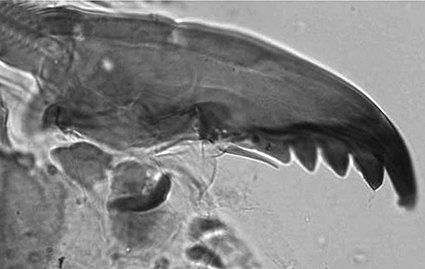Abstract
The larva of Clunio marinus Haliday is described based on field and reared material, collected along the coast of Vigo (Spain) and Helgoland (Germany). C. marinus can be easily distinguished from other known European Clunio species on the basis of some species-specific features found in fourth instar larvae. Comparison with related known Clunio species from Europe with comments on their larval morphology are given. The characteristics of the polytene chromosomes of C.marinus from Vigo are presented. The comparative external morphological analysis of the larvae from the two localities shows a certain differentiation at the external morphological level. The reasons for this differentiation are discussed.
References
Abdelsalam, K.M. (2017) The genus Clunio Haliday, 1855 from Egypt (Hurghada, Red Sea) with a description of the larva of Clunio sp.1 (Diptera, Chironomidae, Orthocladiinae). Polish Journal of Entomology, 86, 39–47. https://doi.org/10.1515/pjen-2017-0003
Cranston, P.S., Oliver, D.R. & Sæther, O.A. (1989) The adult males of Orthocladiinae (Diptera: Chironomidae) of the Holarctic Region—keys and diagnoses. Entomologica Scandinavica Supplement, 34, 164–352.
Heimbach, F. (1978) Sympatric species, Clunio marinus Hal. and C. balticus n. sp. (Dipt., Chironomidae), isolated by differences in diel emergence time. Oecologia, 32, 195–202. https://doi.org/10.1007/BF00366071
Kaiser, T., Neumann, D., Heckel, D. & Berndonk, Th. (2010) Strong genetic differentiation and postglacial origin of populations in the marine midge Clunio marinus (Chironomidae, Diptera). Molecular Ecology, 19, 2845–2857. https://doi.org/10.1111/j.1365-294X.2010.04706.x
Kiknadze, I.I., Istomina, A., Goligina, V. & Gunderina, L. (2016) Karyotypes of Palearctic and Holarctic species of the genus Chironomus. GEO, Novosibirsk, 490 pp.
UDK 576.316.353.7/632.771
Michailova, P. (1980) A review of the European species of genus Clunio Haliday, 1855 (Diptera, Chironomidae). Zoologischer Anzeiger, 205 (5/6), 417–432.
Michailova, P. (1989) The polytene chromosomes and their significance to the systematics of the family Diptera. Acta Zoologica Fennica, 186, 1–107.
Moubayed-Breil, J.& Michailova, P. (2020) Description of the adult and larva of Clunio balticus Heimbach, 1978 (Diptera,Chironomidae) from the seashore of Bergen (Norway). Zootaxa, 4822 (2), 209–220. https://doi.org/10.11646/zootaxa.4822.2.4
Moubayed-Breil, J., Michailova, P. & Langton, P.H. (2020) Description of the adult and immature stages of Clunio ponticus Michailova, 1980 (Diptera, Chironomidae) from the Black Sea, Varna, Bulgaria. Chironomus Journal of Chironomidae Researches, 33, 31– 47. https://doi.org/10.5324/cjcr.v0i33.3332
Olander, R. & Palmen, E. (1968) Taxonomy, ecology and behavior of the northern Baltic Clunio marinus Halid. (Dipt., Chironomidae). Annales Zoologici Fennici, 5, 97–110.
Sæther, O.A. (1980) Glossary of chironomid morphology terminology (Diptera: Chironomidae). Entomologica Scandinavica Supplement, 14, 1–51.
Strenzke, K. (1960) Metamorphose und verwadtschaftsbeziehungen der gattung Clunio Hal. (Dipt.). Terrestrische Chironomidae XXIV. Annales Zoologigi Societatis Zoologigae Botanicae Fennicae ‘Vasamo’, 22 (4), 1–30.
Tasdemir, A. (2010) Clunio Haliday, 1855: A new chironomid genus for Turkey (Diptera, Chironomidae). Journal of the Entomological Research Society, 12 (3), 39–43.
Zhimulev, I. (1996) Morphology and Structure of Polytene chromosomes. Advances in Genetics, 34, 1–311. https://doi.org/10.1016/S0065-2660(08)60533-7


